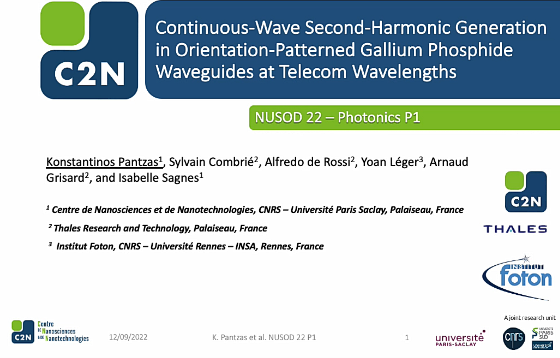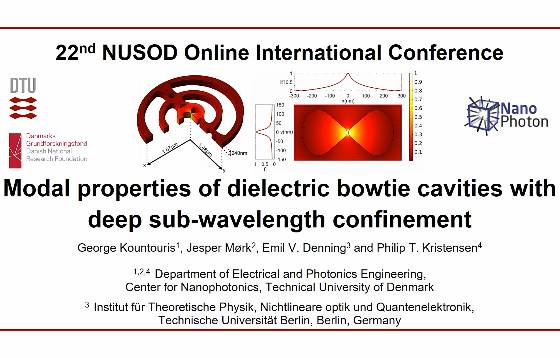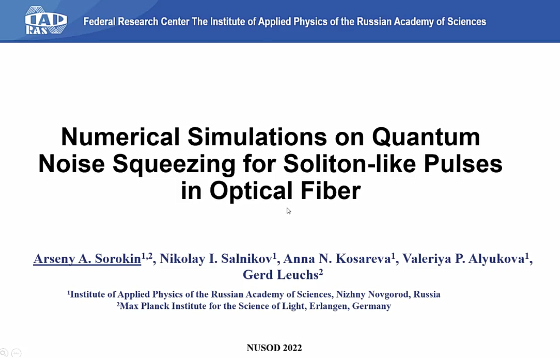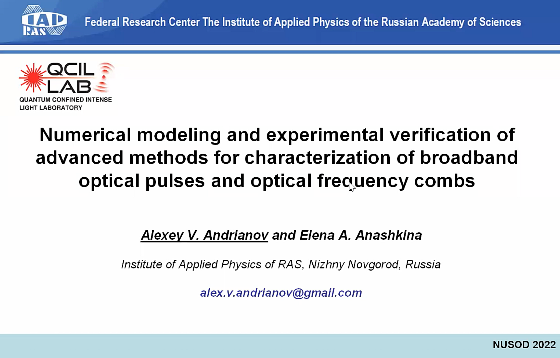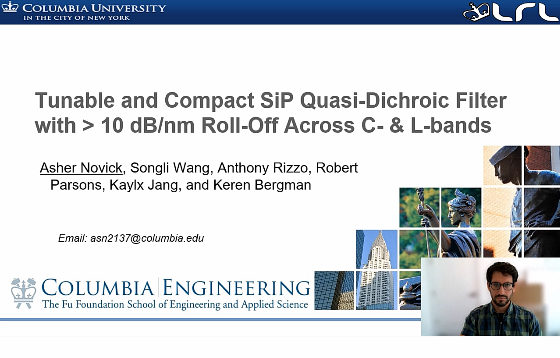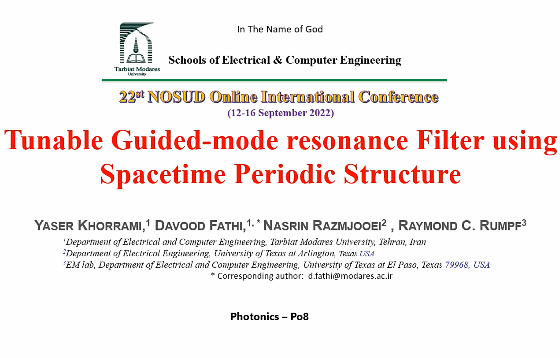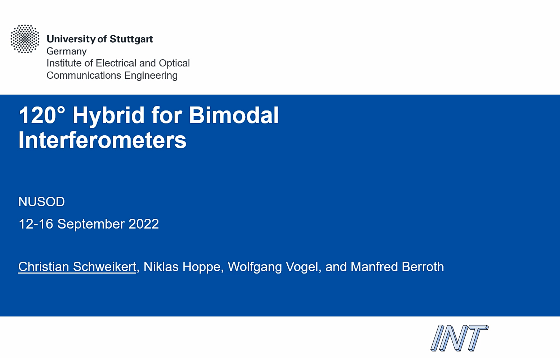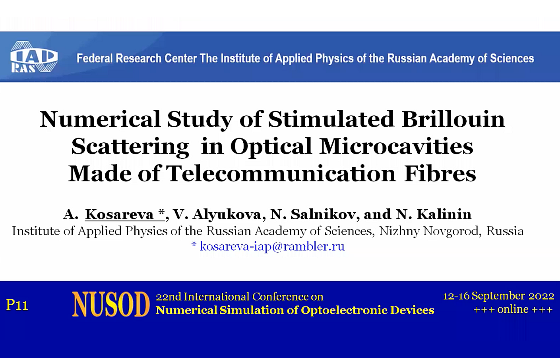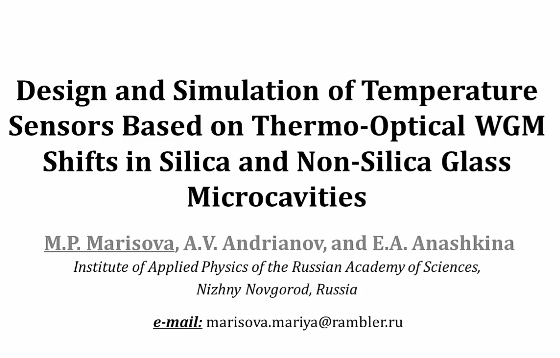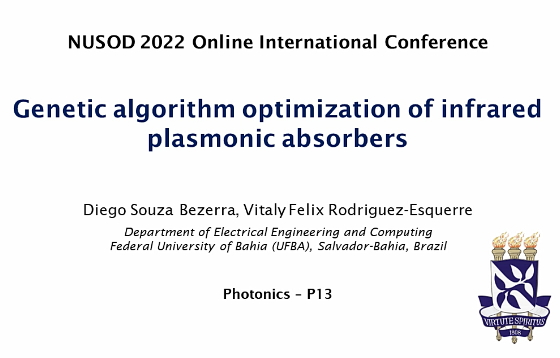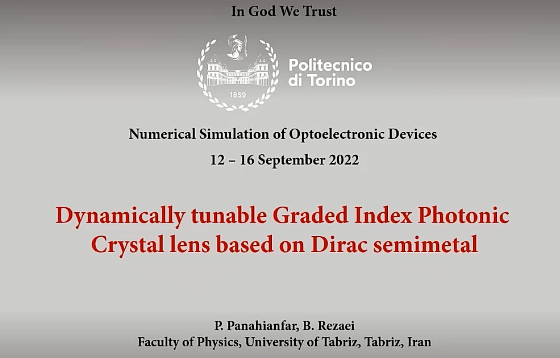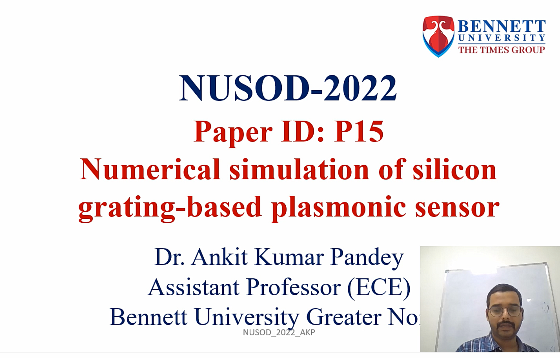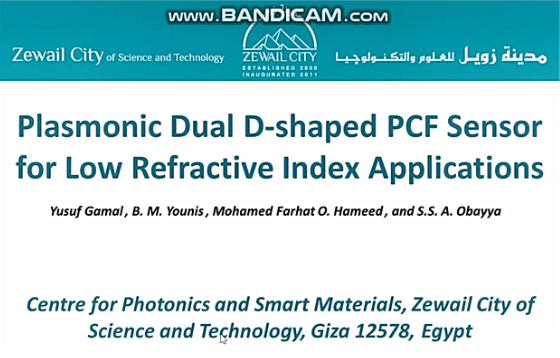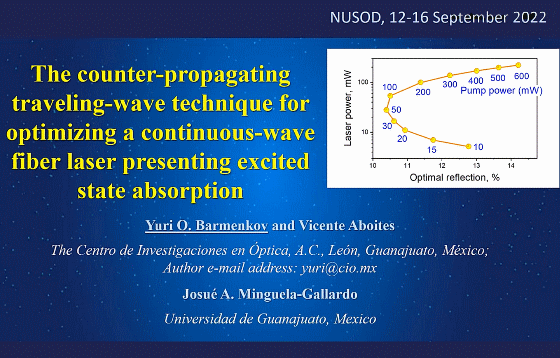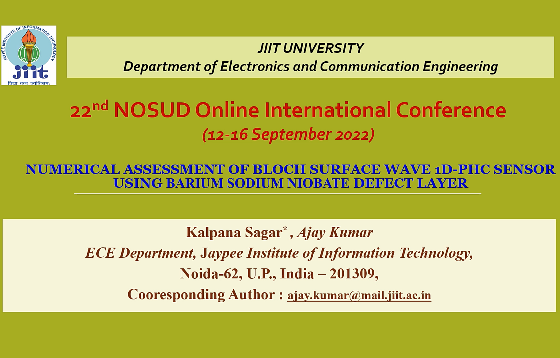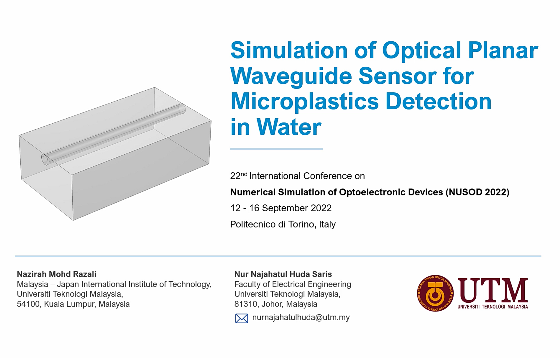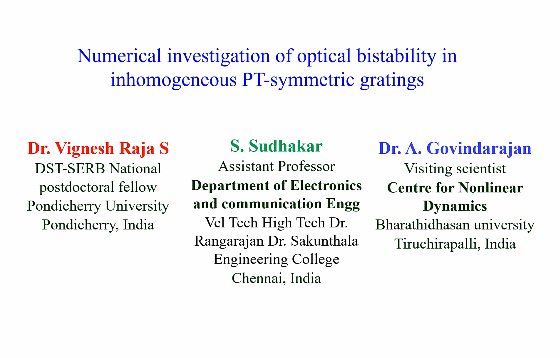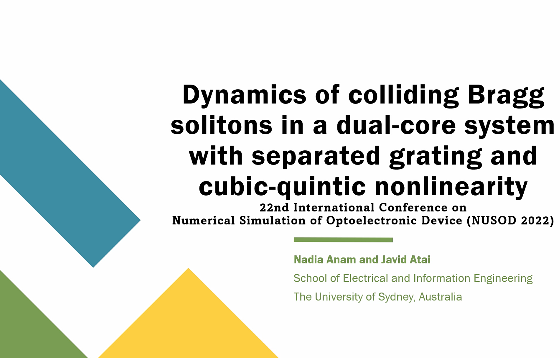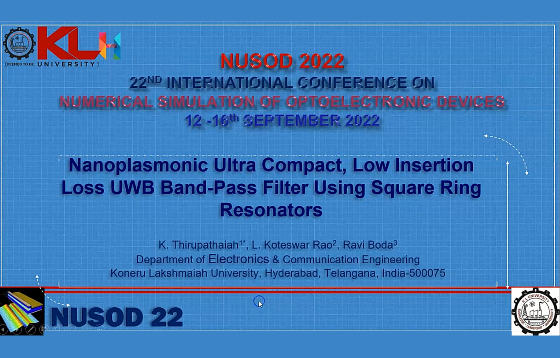


A new process to produce Orientation-Patterned Gallium Phosphide (OP-GaP) on GaAs with almost perfectly parallel domain boundaries is presented. Taking advantage of the chemical selectivity between phosphides and arsenides, OP-GaP is processed into suspended shallow-ridge waveguides. Efficient Second-Harmonic Generation from Telecom wavelengths is achieved in both Type-I and Type-II polarisation configurations. The highest observed conversion […]
P02 – Modal properties of dielectric bowtie cavities with deep sub-wavelength confinement
We present a quasinormal mode analysis of a dielectric bowtie cavity with deep sub-wavelength confinement. The cavity – which is based on an inverse design by topology optimization – exhibits a remarkable sensitivity to local shape deformations, which we show to be well described by perturbation theory.
P03 – Numerical Simulations on Quantum Noise Squeezing for Soliton-like Pulses in Optical Fiber
Generation of light with nonclassical properties, such as squeezed light, has gathered a lot of attention because of possible uses in such areas as quantum state engineering, quantum imaging, continuous variable quantum computing, and detection of gravitational waves. Squeezed light is generally produced by transporting light through a nonlinear medium. One such media is Kerr-nonlinear […]
P04 – Numerical modeling and experimental verification of advanced methods for characterization of broadband optical pulses and optical frequency combs
We propose novel linear method for measuring ultrafast pulse trains with extremely high pulse repetition rates that are commonly generated in nonlinear microresonators. The method combines single-shot spectral interferometry with the reference pulses and an advanced version of the frequency resolved optical gating algorithm to reconstruct the initially unknown reference pulses.
P05 – Tunable and Compact SiP Quasi-Dichroic Filter with ≥10 dB/nm Roll-Off Across C- & L-bands
We report simulated performance for an integrated and compact silicon photonic quasi-dichroic filter with ≥10 dB/nm roll-off and ≥20 dB extinction ratio between pass and stop bands. Additionally, the cutoff wavelength and compensation for fabrication error are each thermally tunable. The functional dichroic bandwidth is ≈80 nm, which spans most practical use cases.
P06 – Flexible, Process-Aware Compact Model of Effective Index in Silicon Waveguides for Commercial Foundries
We report the performance of a compact model for the effective index of SOI wire waveguides, showing exceptional agreement with simulated effective index and confinement factors. The development of such a model represents a potential pathway toward better modeling of silicon photonic devices in commercial foundry processes.
P07 – Low-Cross-Talk Metal-Dielectric-Metal Waveguide Intersections Based on Sodium
We analyzed the transmission properties of two plasmonic waveguides crossing by using numerical simulations. The subwavelength width waveguides are composed of sodiumair-sodium. The crossing structure is composed by a compact cross-shaped resonant cavity with a four-fold symmetry. The results demonstrated the feasibility of using sodium as a low loss material for several applications for nanoplasmonic […]
P08 – Tunable Guided-mode resonance filter using Spacetime Periodic Structure
We present a tunable planar guided-mode resonance (GMR) filter using time-varying permittivity along grating nanobars. Results show that the effective medium concept in the temporal state is exactly the same as the spatial state. Furthermore, the structure has spatial periodicity to save the resonance peak of the passive GMR in addition to the temporal periodicity […]
P09 – 120° Hybrid for Bimodal Interferometers
An 120° hybrid for bimodal interferometers in the 220 nm silicon-on-insulator technology is presented. Three output signals enable an unambiguous phase detection over a 360°-range as well as a constant sensitivity. The length of the hybrid is only 190 µm with a simulated excess loss of 0.16 dB. Measurements combined with digital signal processing verify […]
P10 – Ultraviolet and Infrared Blocking Meta-glasses for Electric Vehicles
The air-conditioning systems installed in electric vehicles (EVs) consume a significant portion of battery power, thus, limiting EVs’ operating mileage. A design of an automobile windshield that can passively control the heat and light transmitted through it, could improve EV’s performance by reducing the need for air-conditioning. Here, we present a ‘meta-glass’ coating design that […]
P11 – Numerical Study of Stimulated Brillouin Scattering in Optical Microcavities Made of Telecommunication Fibres
We numerically studied stimulated Brillouin scattering processes up to the 5th order is microcavities with various realistic diameters and Q-factors made of standard telecommunication fibres. Pump power thresholds were simulated for different parameters of the system. The larger the microcavity and lower Q-factors, the higher pump power thresholds are. It is also shown that thresholds […]
P12 – Design and Simulation of Temperature Sensors Based on Thermo-Optical WGM Shifts in Silica and Non-Silica Glass Microcavities
Sensing applications of dielectric microcavities with whispering-gallery modes (WGMs) have been actively studied in the recent years. Here we investigated theoretically temperature microsensors based on different glasses, including common silica glass, as well as special germanate, tungsten-tellurite, arsenic sulfide and arsenic selenide glasses. We developed numerical model describing sensing characteristics of the considered microcavities. We […]
P13 – Genetic algorithm optimization of infrared plasmonic absorbers
The absorption of a multiband absorber based on a periodical plasmonic grating has been optimized. The optical and geometrical parameters of the plasmonic structure which is composed of germanium and gold are determined by an efficient genetic algorithm. The electromagnetic response of the absorber is numerically obtained by using the frequency domain finite element method. […]
P14 – Dynamically tunable Graded Index Photonic Crystal lens based on Dirac semimetal
In this paper, we design a graded-index photonic crystal based on Dirac semimetals and simulate the light propagation in the proposed structure using two-dimensional finite-difference time-domain method. The numerical results indicate that the designed GRIN PC has focusing capability for incident light at terahertz frequency range, and its focal distance can be tuned through changing […]
P15 – Numerical simulation of silicon grating-based plasmonic sensor
This work reports on the application of silicon grating-enabled nanostructure for refractive index sensing application in the near-infrared region. This grating helps in launching the plasmon modes efficiently towards the flat metal film deposited with a thin Al2O3 layer. The normal incidence light is used which can be helpful for its integration with optical fiber. […]
P16 – Plasmonic Dual D-shaped PCF Sensor for Low Refractive Index Applications
Dual D-shaped (DD-shaped) plasmonic photonic crystal fiber (PCF) for refractive index sensing is designed and analyzed. In the proposed design, two gold nano-rods are attached to the two etched surfaces of the PCF to enhance the sensing characteristics. The surface plasmon (SP) modes excited at the metal/dielectric interfaces are strongly coupled to the PCF core […]
P17 – Simulation Analysis of Microring Resonator in Mobius Topology
In this paper, a microring resonator in Mobius topology is modelled and simulation analysis is carried out. The free spectral range of this silicon-on-insulator based photonic device is found to be 23.4 nm. This structure of microring resonator finds place in various applications such as sensors, polarization analysis, wavelength-selective reflectors.
P18 – The counter-propagating traveling-wave technique for optimizing a continuous-wave fiber laser presenting excited state absorption
We report results of simulation of a continuous-wave fiber laser with active medium presenting an excited state absorption. The laser was simulated using the counterpropagating traveling-wave technique with taking into account two laser waves propagating along the laser cavity in opposite directions, two waves of amplified spontaneous emission, and exited state absorption observed for both […]
P19 – Numerical Assessment of Bloch Surface Wave 1D-PhC Sensor using Ba2NaNb5O15 Defect Layer
In this paper, a top defective layer of Barium sodium niobate (Ba2NaNb5O15) material of nanometer range thickness is used to confine Bloch surface mode at the upper interface of the proposed structure. For a 1275 nm operating wavelength, the structural characteristics are intended to stimulate a BSW at the top interface. Wavelength interrogation, angle interrogation, […]
P20 – Simulation of Optical Planar Waveguide Sensor for Microplastics Detection in Water
Nowadays, microplastics pollution has become a global concern as it endangers the ecology, marine animals, and cause health threats to human beings. This paper attempted to simulate an optical planar waveguide sensor for microplastics detection in water via Wave Optics Module-COMSOL Multiphysics®. The analyte refractive index was ranged from 1.4800 to 1.5000 RIU, in reference […]
P21 – Numerical investigation of optical bistability in inhomogeneous PT -symmetric gratings
Customizing the nonlinear profile along the direction of propagation helps in the realization of low-power all-optical switches. The switching intensities are extremely low (<0.01) in the broken regime provided that the light launching direction is right. It is believed that the switching intensities in the broken regime are always higher than that of the unbroken […]
P22 – Dynamics of colliding Bragg solitons in a dual-core system with separated grating and cubic-quintic nonlinearity
We investigate the collisions of counterpropagating Bragg solitons in a dual-core optical coupler where one core has cubic-quintic nonlinearity and is coupled to another linear core equipped with a uniform Bragg grating. The outcomes of the collisions are diverse and exhibit rich dynamics.
P23 – Nanoplasmonic Ultra Compact, Low Insertion Loss UWB Band-Pass Filter Using Square Ring Resonators
This article presents the design and analysis of a nanoplasmonic ultra wide band (UWB) band-pass filter based on metal insulator metal (MIM) slot-waveguide using three square ring resonators (SRRs) for obtaining ultra wide band nature at optical frequencies. This filter shows the low insertion loss due to the zero coupling gaps and no mismatch between […]

